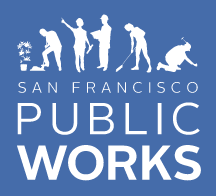For immediate release: Jan. 2, 2015
Contact: Rachel Gordon, 415-554-6045
San Francisco Street Pavement Condition Improves for Third Straight Year
Annual assessment shows steady progress in road quality citywide
San Francisco, CA – Mayor Ed Lee and Public Works Director Mohammed Nuru today announced the results of a roadway condition survey that shows the quality of the City’s streets continues to improve, thanks in large part to the voter-approved $248 million 2011 Road Repaving and Street Safety bond.
Public Works resurfaced and treated a record-high 913 blocks in fiscal year 2014, eclipsing the last record set in 2013 when 854 blocks were resurfaced. Public Works reported a citywide average Pavement Condition Index score of 67 for calendar year 2014, up from a score of 66 in 2013. The information is tracked by the regional Metropolitan Transportation Commission, which assesses the condition of Bay Area roads.
Since the infusion of funding from the streets bond, the City has been able to pave more streets than ever before, with the citywide average score increasing annually -- toppling the 10-year average of 64.
“San Francisco has been able to pave more streets than ever before and has shown that our City’s streets are continuing to improve,” said Mayor Lee. “As a result of the 2011 Street Repaving Bond and combined with the recently approved $500 million Transportation Bond, we are making greater investments in our transportation infrastructure that will allow our residents to move around the City better, faster and safer.”
The Pavement Condition Index assigns City blocks a score from a low of zero for a badly deteriorated road to a high of 100 for a freshly paved block. Public Works tracks the impacts of wear, erosion and aging of each street, and assesses street deterioration with a rating for each of the City’s 12,855 blocks.
The assessment is based on visual surveys performed by specially trained and certified staff. Each segment is evaluated based on ride quality, cracking and signs that the roadway may be breaking up in places.
“The quality of our streets is no longer in decline, and you really have to hand it to the people of San Francisco who put their faith in us to achieve these goals,” said San Francisco Public Works Director Mohammed Nuru. “Cyclists, drivers, pedestrians and Muni riders will more and more see the results of this hard work, planning and coordination that is making our streets smoother and safer.”
A Pavement Condition Index score of 85-100 is rated as “excellent,” 64-84 “good,” 50-63 “fair,” and 0-49 “poor.” About half of San Francisco City blocks are rated at good or excellent and 23 percent are currently listed in the poor category.
The average score for San Francisco roads peaked at 77 in the late 1980s and gradually declined down to the low point of 64, where the average score hovered for a decade. If current funding levels are maintained, the citywide average Pavement Condition Index can improve to 70 in fewer than 10 years. The new 2014 rating surpasses the current California statewide average of 66.
San Francisco voters passed the $248 million Road Repaving and Street Safety bond in November 2011 at a time when the condition of City streets was at a critical juncture. Prior to passage of the three-year Streets Bond, San Francisco paved and resurfaced about 400 blocks a year – less than half of today’s pace. About 2,400, or 20 percent, of San Francisco’s City-maintained blocks will be treated by the end of 2015 -- half funded with proceeds from the 2011 Streets Bond and the others paid for with different sources of local and state money.
Significant street resurfacing projects in the last year included work in every San Francisco neighborhood, with dozens of blocks paved on 20th Avenue, Lincoln Way, Guerrero Street, Alemany Boulevard, and Pine, Sacramento, Stockton streets.
Public Works’ cost‐effective pavement-management strategy preserves streets in good condition instead of letting them deteriorate. The cost to reconstruct a street segment that is in poor condition versus making pavement preservation treatments to a segment that is in good condition can be considerably more expensive. Extending the life of a block in San Francisco that is in good condition can cost around $24,000. The complete reconstruction of an average sized block in poor or very poor condition, including repairs to the concrete base and the top layer of asphalt, can be as high as $520,000. These strategic preservation treatments can increase the life cycle of each block and reduce the lifetime costs per block.
The City is responsible for maintaining approximately 940 miles of streets. More information on the Streets Bond, including a listing of City blocks in the resurfacing program, can be found at streetsbondsf.org.
About San Francisco Public Works: The 24/7 City agency cleans and resurfaces streets; plants and nurtures City-maintained street trees; designs, constructs and maintains City-owned facilities; inspects streets and sidewalks; builds curb ramps; eradicates graffiti; partners with neighborhoods; trains people for jobs; greens the right of way; and educates our communities.
###
San Francisco, CA 94103


